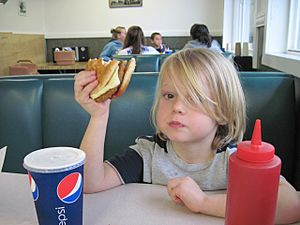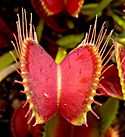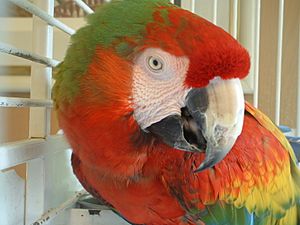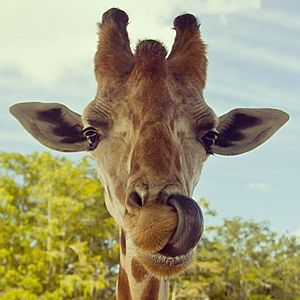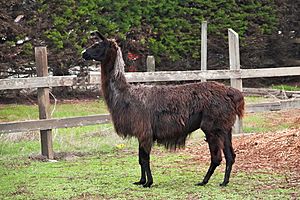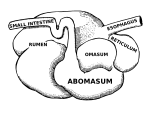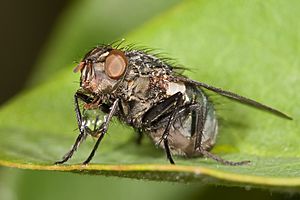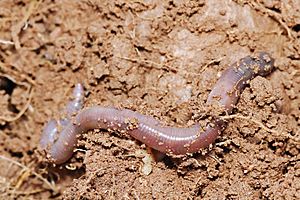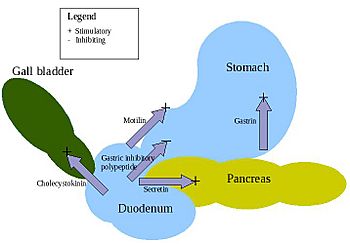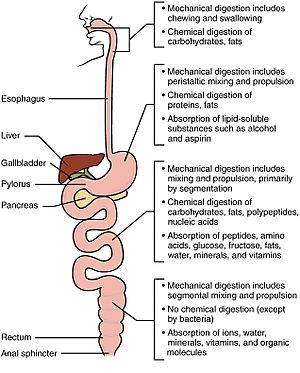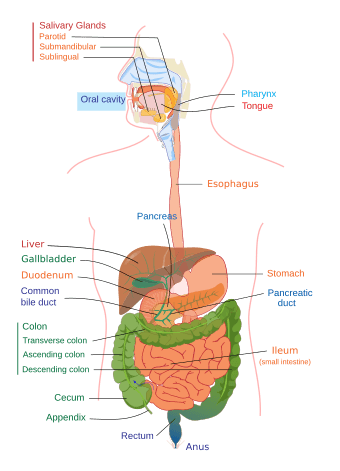Digestion facts for kids
Quick facts for kids Digestive system |
|
|---|---|
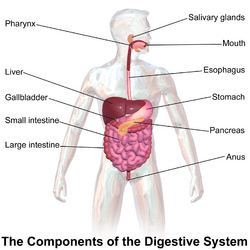 |
|
| Latin | systema digestorium |
When we eat, our body needs to digest food. This helps us get the vitamins, minerals, and other nutrients from what we eat. Digestion happens in our "gastro-intestinal system."
Digestion mainly works in three steps:
- We chew our food with our teeth. This breaks food into smaller pieces. Our saliva (the liquid in our mouths) also starts a chemical reaction to begin digestion.
- In our stomach, special chemicals called enzymes change the food. They turn it into tiny molecules that our body can use.
- After food becomes small molecules, our blood carries these molecules to different parts of the body.
Let's follow the food's journey through your body:
- First, we chew food, making it smaller.
- Saliva in our mouths has enzymes that start breaking down food even more.
- We swallow the food, and it goes down to the stomach.
- In the stomach, chemicals turn the food into a thick liquid, like soup. This takes about one or two hours.
- This liquid then moves into the small intestine. Here, our bodies absorb the nutrients from the food. The small intestine is about 6 meters (20 feet) long! This gives plenty of time for nutrients to be absorbed.
- Things that are not absorbed are called "solid waste." This waste goes to the large intestine.
- The large intestine mixes the solid waste with water. This makes it easier for us to eliminate it from our bodies.
- The solid waste stays in the rectum until we go to the toilet. Then, it leaves our bodies through the anus.
Contents
How Animals Digest Food
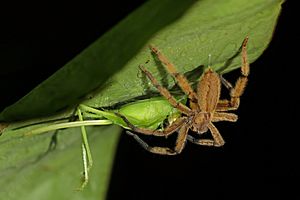
Digestive systems come in many different forms. Some animals digest food outside their bodies, and others digest it inside. External digestion came first in history. Most fungi still use it. They release enzymes into their surroundings. These enzymes break down organic material. Then, the fungi absorb some of the broken-down parts.
Animals have a tube called a gastrointestinal tract. This is where internal digestion happens. It's better because the animal can capture more of the broken-down food. Also, the inside of the body can control the chemical environment better.
Some animals, like almost all spiders, release chemicals and poisons onto their prey. These turn the prey into a "soup" before the spider eats it. Other animals eat their food first. Then, digestion happens inside special sacs, tubes, or organs. These parts help the animal absorb nutrients more easily.
Gastrovascular Cavity
A gastrovascular cavity acts like a stomach. It helps both digest food and send nutrients to all parts of the body.
For example, the Venus flytrap is a plant that makes its own food using sunlight (photosynthesis). It doesn't eat insects for energy. Instead, it catches prey mainly to get important nutrients like nitrogen and phosphorus. These nutrients are hard to find in the swampy, acidic places where it grows.
Special Body Parts for Digestion
Animals have developed many body parts to help them digest food. These include beaks, tongues, teeth, a crop, and a gizzard.
Beaks
Birds have hard, bony beaks. For instance, macaws eat seeds, nuts, and fruit. They use their strong beaks to open even the toughest seeds. They first make a thin line with the sharp tip of their beak. Then, they use the sides of the beak to shear the seed open.
The mouth of a squid has a sharp, hard beak. It is mostly made of proteins. The squid uses it to kill prey and tear it into smaller pieces. This beak is very strong. But unlike the teeth of many other animals, it does not contain minerals. The beak is the only part of a squid that cannot be digested.
Tongue
The tongue is a muscle in the bottom of the mouth for most animals with backbones. It moves food around for chewing and swallowing. It is very sensitive and kept wet by saliva.
The bottom of the tongue has a smooth lining. The tongue also helps us feel where food particles are. This helps us move them for more chewing.
The tongue helps roll food into a ball called a bolus. This ball is then moved down the esophagus by muscle movements called peristalsis.
Teeth
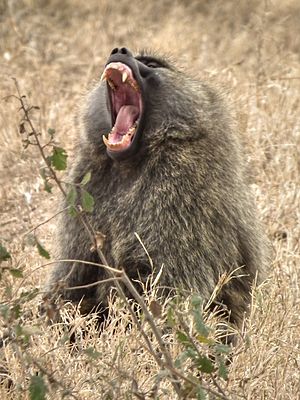
Teeth are small, whitish parts found in the jaws or mouths of many animals with backbones. They are used to tear, scrape, and chew food. Teeth are not made of bone. Instead, they are made of different hard tissues like enamel and dentine.
Human teeth have blood and nerves. This allows us to feel when we chew. For example, if we bite something too hard, our teeth send a message to our brain. We then know to stop chewing it.
The shape, size, and number of teeth in animals depend on what they eat. For instance, plant-eating animals (herbivores) have many molars. These teeth grind plant material, which is hard to digest. Meat-eating animals (carnivores) have canine teeth. These are used to kill and tear meat.
Crop
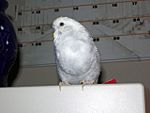
A crop is a thin, expanded part of the digestive tract. It stores food before digestion. In some birds, it is a muscular pouch near the throat. Adult doves and pigeons can make "crop milk" in their crop. They use this to feed their baby birds.
Some insects also have a crop or a larger esophagus.
Abomasum
Plant-eating animals called ruminants have a special stomach with four parts. These are the rumen, reticulum, omasum, and abomasum.
In the first two parts, the rumen and reticulum, food mixes with saliva. It separates into solid and liquid layers. Solids form a clump called cud. The animal then brings the cud back up to its mouth. It chews the cud slowly to mix it well with saliva and break it into tiny pieces.
Special microbes (like bacteria and fungi) in these chambers break down tough plant fibers. In the omasum, water and minerals are absorbed into the blood.
The abomasum is the fourth and last part of a ruminant's stomach. It works much like a human stomach. Here, acids break down proteins from microbes and food. This prepares them for more digestion and absorption in the small intestine. Finally, the food moves to the small intestine. Here, nutrients are digested and absorbed. The microbes made in the rumen are also digested here.
Special Eating Habits
Regurgitation is when an animal brings food back up from its stomach. For example, pigeons and doves make "crop milk" in their crop. They feed this to their young by bringing it back up.
Many sharks can turn their stomachs inside out and push them out of their mouths. They do this to get rid of unwanted things they ate. This might help them avoid poisons.
Other animals, like rabbits and rodents, eat their own specialized poop. This is called coprophagia. They do this to digest food again, especially tough plant material. Animals like capybaras, rabbits, and hamsters don't have complex digestive systems like ruminants. So, they get more nutrition from grass by digesting their food twice. They produce soft, partially digested pellets. They usually eat these right away. They also make normal droppings, which they don't eat.
Young elephants, pandas, koalas, and hippos eat their mothers' poop. They likely do this to get the right bacteria needed to digest plants properly. When they are born, their intestines are clean and have no bacteria. Without these bacteria, they couldn't get nutrients from many plant parts.
Earthworm Digestion
An earthworm's digestive system includes a mouth, pharynx, esophagus, crop, gizzard, and intestine. The mouth has strong lips. These lips act like hands to grab pieces of dead grass, leaves, and weeds, along with bits of soil.
The lips break food into smaller pieces. In the pharynx, mucus makes the food slippery for easier movement. The esophagus adds calcium carbonate to balance acids from decaying food.
Food is stored temporarily in the crop, where it mixes with calcium carbonate. The gizzard's strong muscles churn and mix the food and dirt. After churning, glands in the gizzard's walls add enzymes. These enzymes help break down the organic matter chemically.
Muscle movements (peristalsis) send the mixture to the intestine. Here, helpful bacteria continue the chemical breakdown. This releases carbohydrates, protein, fat, and various vitamins and minerals. These are then absorbed into the earthworm's body.
How Vertebrates Digest Food
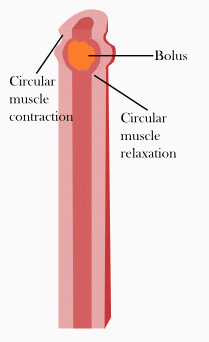
In most animals with backbones (vertebrates), digestion has many steps. It starts when they eat raw materials, often other organisms. Eating usually involves breaking down food both mechanically and chemically.
Digestion has four main steps:
- Ingestion: This is putting food into the mouth. It's how food enters the digestive system.
- Mechanical and chemical breakdown: This involves chewing food and mixing it with water, acids, bile, and enzymes in the stomach and intestine. This breaks down complex food molecules into simpler ones.
- Absorption: This is when nutrients move from the digestive system into the blood and lymph. This happens through processes like osmosis and active transport.
- Egestion (Excretion): This is removing undigested materials from the digestive tract. It happens through defecation.
Throughout the whole process, muscles move food along the system. This happens through swallowing and peristalsis. Each step of digestion uses energy. This means there's an "energy cost" to get nutrients from food. Differences in this cost affect an animal's lifestyle and body. For example, humans are different from other apes in many ways, like having less hair and different teeth.
Most digestion happens in the small intestine. The large intestine mainly ferments undigested material using gut bacteria. It also absorbs water from the digested food before it is removed from the body.
In mammals, digestion starts even before food enters the stomach. This is called the cephalic phase. During this time, saliva is made in the mouth, and digestive enzymes are made in the stomach. Mechanical and chemical digestion begin in the mouth. Food is chewed and mixed with saliva to start breaking down starches. The stomach continues to break down food. It churns and mixes food with acids and enzymes. Absorption happens in the stomach and gastrointestinal tract. The process ends with defecation.
Human Digestion Process
The human gastrointestinal tract is about 9 meters (30 feet) long. How food digests can change from person to person. It also depends on the food and meal size. Digestion usually takes between 24 and 72 hours.
Digestion starts in the mouth. Saliva and its digestive enzymes are released. Food is formed into a bolus by chewing. Then, it is swallowed into the esophagus. From there, it enters the stomach through peristalsis. Gastric juice in the stomach contains hydrochloric acid and pepsin. These could harm the stomach walls. So, mucus is released to protect them. In the stomach, more enzymes break down food further. The stomach also churns and mixes the food.
The partly digested food enters the duodenum as a thick, semi-liquid mixture called chyme. Most digestion happens in the small intestine. This is helped by fluids from bile, pancreatic juice, and intestinal juice. The walls of the intestine have tiny folds called villi. Their cells are covered with many even tinier folds called microvilli. These folds increase the surface area of the intestine. This helps absorb more nutrients.
In the large intestine, food moves slower. This allows gut flora (helpful bacteria) to ferment it. Water is absorbed here. Waste material is stored as feces. It is then removed from the body by defecation through the anal canal and anus.
Images for kids
See also
 In Spanish: Digestión para niños
In Spanish: Digestión para niños


